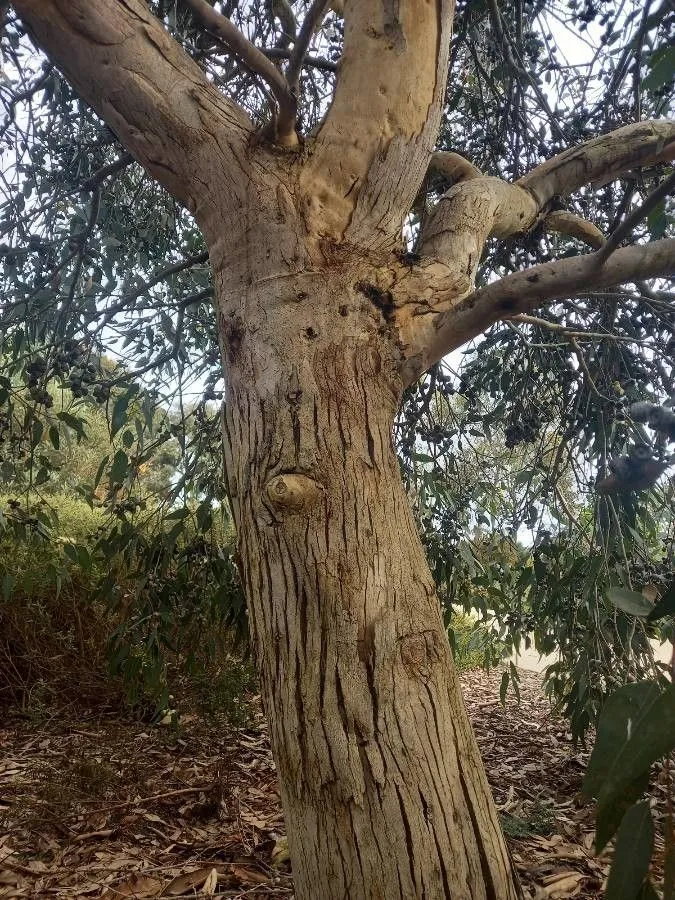
Author: F.Muell.
Bibliography: Trans. Philos. Soc. Victoria 1: 32 (1855)
Year: 1855
Status: accepted
Rank: species
Genus: Eucalyptus
Vegetable: False
Observations: SE. South Australia
The Bog Gum, scientifically known as Eucalyptus cosmophylla, is an endemic species predominantly found in the southeastern regions of South Australia. First described by the renowned botanist Ferdinand von Mueller in 1855, this plant’s description was published in the Transactions of the Philosophical Society of Victoria.
Eucalyptus cosmophylla belongs to the Myrtaceae family which is known for its aromatic oils and significant ecological role in Australian landscapes. This species shares the common structural and physiological traits typical of the Eucalyptus genus, such as lanceolate leaves, woody fruit capsules, and a high tolerance to varying soil and climatic conditions.
Characteristically, the Bog Gum thrives in well-drained, swampy soils typically found in its native habitat. This adaptability to boggy ground distinguishes it from some other eucalyptus species, making it a unique and critical component of the local biome.
Botanically, the plant displays the hallmark features of the eucalypt family, with robust, evergreen foliage that provides consistent shelter and food for local wildlife. The leaves of Eucalyptus cosmophylla are leathery and often exhibit a glossy surface, playing a crucial role in reducing water loss through transpiration in the often harsh Australian climate. The bark of the tree adds to its rugged beauty, presenting a smooth yet slightly rough texture that can peel in ribbons, characteristic of many eucalypt species.
Eucalyptus cosmophylla’s flowers, blooming typically in the warmer months, are a visual spectacle of creamy-white to pale pink hues. These blossoms are not only visually appealing but also serve as a vital nectar source for numerous insect species, including native bees and birds, ensuring the process of pollination that is essential for ecosystem sustainability.
Due to its specific habitat requirements and distribution, the Bog Gum serves as an important indicator species for environmental health within its range. Conservation efforts aim to protect this unique flora, ensuring it remains a thriving part of southeastern Australia’s natural heritage.
In summary, Eucalyptus cosmophylla, or the Bog Gum, is a remarkable representation of Australia’s diverse plant life. Its ecological significance, combined with its distinctive botanical features, underscores the importance of preserving such species to maintain the natural balance and biodiversity of the region.
Eng: bog gum, bog-gum, cup gum, cup-gum
Por: eucalipto
En: Bog gum, Bog-gum, Cup gum, Cup-gum
Pt: Eucalipto
Taken May 7, 2021 by dylan bennett (cc-by-sa)
Taken May 7, 2021 by dylan bennett (cc-by-sa)
Taken May 7, 2021 by dylan bennett (cc-by-sa)
Taken May 7, 2021 by dylan bennett (cc-by-sa)
© copyright of the Board of Trustees of the Royal Botanic Gardens, Kew.
Family: Myrtaceae Author: (F.Muell.) K.D.Hill & L.A.S.Johnson Bibliography: Telopea 6: 402 (1995) Year: 1995 Status:…
Family: Rubiaceae Author: Pierre ex A.Froehner Bibliography: Notizbl. Bot. Gart. Berlin-Dahlem 1: 237 (1897) Year:…
Family: Sapindaceae Author: Koidz. Bibliography: J. Coll. Sci. Imp. Univ. Tokyo 32(1): 38 (1911) Year:…
Family: Asteraceae Author: A.Gray Bibliography: Pacif. Railr. Rep.: 107 (1857) Year: 1857 Status: accepted Rank:…
Family: Fabaceae Author: Medik. Bibliography: Vorles. Churpfälz. Phys.-Ökon. Ges. 2: 398 (1787) Year: 1787 Status:…
Family: Aspleniaceae Author: (Cav.) Alston Bibliography: Bull. Misc. Inform. Kew 1932: 309 (1932) Year: 1932…